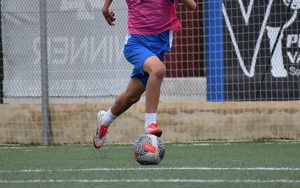Knowing how to recover after intense soccer matches is just as important as your training or match-day performance. When your body goes through 90+ minutes of sprinting, tackling, cutting, and high-concentration play, the real growth and restoration happens after the final whistle. Recovery is what keeps you sharp, consistent, and injury-free.
Top-level players don’t just focus on training hard—they learn how to recover smarter. That’s why in elite soccer programs focused on full-scope player development—including tactical, technical, and physical education—you’ll often see as much attention paid to post-match care as to the match itself, like in the setup at IDA Valencia.
Let’s walk through the ultimate post-match recovery checklist so you can get back to full strength faster—and play at your best, week after week.
Table of Contents
Why Recovery Matters More Than You Think
After a match, your body isn’t just tired—it’s inflamed, dehydrated, and slightly broken down on a cellular level. That’s natural. But without proper recovery, you’re putting yourself at risk for:
❌ Decreased performance in your next session
❌ Muscle fatigue or soreness that lingers for days
❌ Higher chance of injury
❌ Mental burnout and loss of focus
Recovery isn’t being lazy—it’s training your body to adapt and come back stronger.
Step-by-Step: How to Recover After Intense Soccer Matches
💧 1. Rehydrate Immediately After the Game
You can lose over a liter of fluid during one match—sometimes more in hot conditions. Start replenishing right after the whistle.
✅ Drink water slowly and steadily over the next hour
✅ Add electrolytes to replace sodium, potassium, and magnesium
✅ Coconut water or sports drinks (low in sugar) can help, too
Dehydration affects everything from muscle repair to brain function—so don’t skip this.
🍌 2. Refuel With the Right Nutrition
Your muscles are starving after a match. Rebuild them with the right fuel.
Within 30–60 minutes after the game, eat:
- Carbs to refill glycogen stores (rice, sweet potatoes, whole-grain bread)
- Protein to repair tissue (chicken, eggs, Greek yogurt, protein shake)
- Healthy fats to reduce inflammation (avocado, nuts, olive oil)
🍽️ Example recovery meal:
Grilled chicken, quinoa, spinach, olive oil, and a banana on the side.
🚿 3. Take a Contrast Shower or Ice Bath
Alternating between hot and cold water or taking an ice bath can help flush out lactic acid and reduce swelling.
Try this:
- 1 minute cold water
- 1 minute warm water
- Repeat 4–5 times
Or go for a full-body 10-minute ice bath if you’re really sore and used to the cold. 🧊
🧘♂️ 4. Stretch and Do Light Mobility Work
After your shower or bath, spend 10–15 minutes doing gentle recovery movements.
Include:
- Hamstring and quad stretches
- Hip openers
- Calf rolls
- Foam rolling on IT band and glutes
- Shoulder and spine mobility
This helps your muscles cool down without stiffening up, preventing that heavy-leg feeling the next day.
💤 5. Prioritize Quality Sleep
Sleep is the number one recovery tool. Period.
While you sleep:
✅ Muscle fibers rebuild
✅ Hormones balance
✅ The nervous system resets
Aim for 8–9 hours the night after a match. You can even take a 20-minute power nap earlier in the day to support recovery.
Bonus tip: Avoid screens before bed and keep your room dark and cool. 😴
🚶♂️ 6. Do Active Recovery the Next Day
The day after your match, don’t just stay in bed all day (even if you’re sore). Light movement gets the blood flowing and supports healing.
Try this 15–30 minute active recovery:
- Easy cycling 🚴♂️
- Swimming or walking
- Stretching and foam rolling
- Breathing exercises
You’ll feel more mobile by the following training day—and reduce your risk of injury.
🧠 7. Recover Mentally, Too
Physical recovery is half the story—mental reset matters just as much.
Post-match, take time to:
🧘 Reflect on your performance without judgment
✍️ Journal 1 thing you did well and 1 thing you can improve
🎧 Listen to relaxing music or spend quiet time unplugged
High-level performance requires emotional recovery just like muscular recovery.
🧩 8. Listen to Your Body Throughout the Week
Recovery isn’t finished the day after your match. Your training schedule should adjust based on how your body feels.
Here’s a smart rhythm:
- Match Day: Perform
- Day After: Light recovery (mobility, walk, light core)
- Two Days After: Return to training (technical, low intensity)
- Third Day: Higher-intensity work (conditioning, tactical)
If you’re still sore by day two, modify your session. Long-term health > one extra sprint drill.
Tools and Techniques That Can Help Your Recovery Routine
🌀 Foam roller: For large muscle groups and fascia release
🥶 Cold therapy: Ice packs, cold tubs, cryotherapy
🧦 Compression gear: Improves circulation post-match
🔬 Massage guns: Great for deep muscle relief
📱 Recovery apps: Track hydration, HRV, sleep, and soreness
You don’t need every gadget—just a consistent approach that works for your lifestyle and level.
Make Recovery a Habit, Not an Afterthought
Learning how to recover after intense soccer matches is one of the smartest ways to protect your performance, avoid burnout, and keep improving throughout the season. Recovery isn’t a “soft” skill—it’s a competitive edge.
The players who recover well are the ones who show up sharp for every session, bounce back from tough matches, and build long-term success.
And if you’re part of a training environment that treats recovery as part of the full development process—you’ll not only feel better after games… you’ll play better in the next one.
Play hard. Recover smart. Stay ready. ⚽💪🛌




